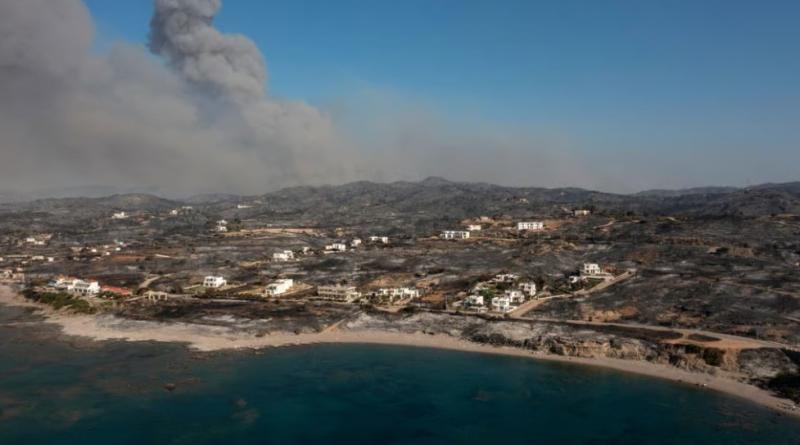This summer is what climate change looks like, scientists say

July’s record temperatures in the Northern Hemisphere driven by climate change, new study finds.
The blistering heat threatening lives and fueling wildfires across Southern Europe and North America this July would have been “virtually impossible” without man-made global warming, scientists said on Tuesday.
Their findings come as the planet’s ocean and land temperatures hit new records in recent weeks, with waters around Florida and the Mediterranean coast surpassing 30 degrees Celsius and parts of the Northern Hemisphere baking in heat of 45C or more.
Scientists have long warned climate change would make heat waves hotter, longer and more frequent. Tuesday’s study found that this month's extreme temperatures are no longer an outlier now that humans have warmed the Earth by about 1.2C above pre-industrial levels.
In fact, “it could well be that this is what will be a cool summer in the future unless we rapidly stop burning fossil fuels,” said study co-author Friederike Otto, a climate scientist at Imperial College London. “This is not the new normal. As long as we keep burning fossil fuels, we will see more and more of these extremes."
The study was published by the World Weather Attribution (WWA) consortium of scientists, which uses peer-reviewed methods to conduct rapid analyses of the role climate change plays in extreme weather events.
The researchers found heat waves like those seen in mid-July can now be expected roughly once a decade in Southern Europe and every 15 years in North America. But if the global average temperature rises to 2C above pre-industrial levels, the upper limit of the 2015 Paris climate agreement, “events like this will become even more frequent, occurring every 2-5 years,” the researchers said.
Current climate policies put the planet on track to warm at least 2.4C by the end of this century.
China, which registered a new temperature record of 52.2C in mid-July, can already expect such heat waves to occur every five years, the WWA study found. Climate change made the Chinese heat wave 50 times more likely to occur, according to their models.
But global warming hasn’t just made such heat waves more likely. It’s also made them more intense.
The study found the European, North American and Chinese heat waves were 2.5C, 2C and 1C hotter, respectively, than they would have been without climate change.
On the ground, these abstract-seeming numbers translate into record-smashing temperatures. In the U.S., the city of Phoenix saw three weeks above 43C; across the Atlantic, Catalonia and Rome hit new heat records last week. Sardinia reached 46C.
Such extreme heat is dangerous to human health. More than 60,000 Europeans died in last summer’s heat waves, a recent study found. Italian hospitals reported an uptick in hospitalizations last week; doctors in the southwestern U.S. are warning of an increase in severe, and sometimes deadly, burns from extreme surface temperatures.
In countries like Canada and Greece, the heat contributed to tinderbox conditions allowing wildfires to spread with ease. The smoke from Canada’s fires continues to choke North American cities, while dramatic evacuation efforts are underway on several Greek islands.
“The Mediterranean has seen a dramatic increase in the frequency of the hot-dry conditions that were considered extreme at the end of the last century, and these increases are expected to accelerate for each added degree of warming in future,” said Matthew Jones, a fellow at East Anglia University’s Tyndall Centre for Climate Change Research.
NASA scientists expect this July to become the world’s hottest month on record.
Other parts of the Northern Hemisphere have seen flash flooding, record-breaking hail, intense storms or a combination of all three this month. Last week, a hail storm sent a flood of ice through the northern Italian town of Seregno.
While scientists say that climate change will fuel extreme precipitation or flash flooding in some parts of the globe, not all such events are attributable to global warming. A WWA study earlier this year, for example, found that climate change had no significant impact on deadly spring floods in Italy.
Attributing heat waves to climate change is a more straightforward matter, and numerous studies have found a clear link.
“It's a very boring study, from a scientific point of view,” said Otto. “We see exactly what we expected to see.”
She also said that the arrival of El Niño — the warming cycle of a naturally occurring phenomenon in the Pacific Ocean — contributed very little to the high temperatures seen across the Northern Hemisphere.
“Increased global temperatures from burning fossil fuels is the main reason the heat waves are so severe,” the study authors noted.
Scientists have also said that El Niño, whose full warming effect won’t be felt until later this year, also isn’t to blame for current sea temperature anomalies in the North Atlantic.
Coastal waters in Florida have reached about 35C — an existential threat to coral reefs — while last month, the sea around the British Isles registered temperatures 5C above normal.
The EU’s Copernicus climate change service, which described the North Atlantic heating as “off the charts,” says a mix of global warming and “unusual” atmospheric circulation is driving the anomaly. Scientists also point to a reduction in shipping pollution and an absence of Saharan dust over the Atlantic as contributing factors.
While the North Atlantic’s temperature spike looks especially dramatic, global sea surface temperatures have hit record highs in recent months.
The arrival of El Niño will fuel warming both in the oceans and on land, boosting the likelihood of extreme weather events, according to the World Meteorological Organization, whose scientists have warned that the planet is entering “uncharted territory.”
As the Northern Hemisphere’s extreme summer goes on, all’s not well on the other side of the planet, either.
Antarctica’s sea ice is in sharp decline, setting new records at such a pace that scientists are increasingly fearing for its capacity to recover in the winter.
Oceanographer Edward Doddridge told the Australian Broadcasting Corporation this weekend the unprecedentedly low sea ice extent “is a five-sigma event. So it's five standard deviations beyond the mean. Which means that if nothing had changed, we'd expect to see a winter like this about once every 7.5 million years.”
Doddridge added the root cause of the decline is likely climate change, although he cautioned that other factors can’t yet be ruled out.
But there’s no doubt that ice loss at the poles further accelerates climate change. The bright ice caps reflect the sun’s warming rays back into space, while the dark polar waters absorb them. Less ice means the planet absorbs more heat.
Earlier this year, a study found the rapidly melting Antarctic ice is slowing deep ocean currents, with potentially devastating consequences for ecosystems and the broader climate.
The authors of Tuesday’s heat study stressed that governments now have to take urgent action on two fronts — reducing emissions to avoid disastrous climate change and enacting measures to adapt to rising temperatures.
“Even if we stop burning fossil fuels today, temperatures will not go down. They will just stop getting even higher,” said Otto. “And so the heat waves we are seeing now, we definitely have to live with that.”
Photograph: Spyros Bakalis/AFP via Getty Images - Smoke rises in the background of Kiotari village on the island of Rhodes





